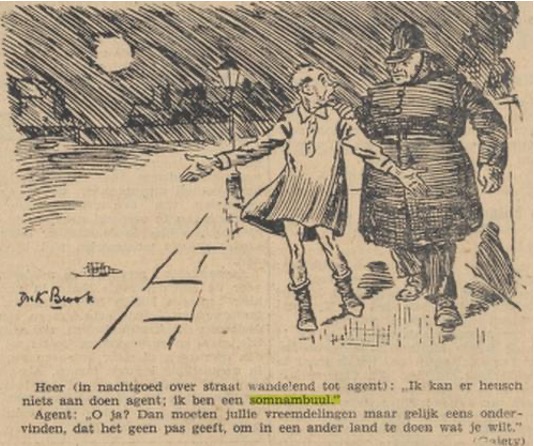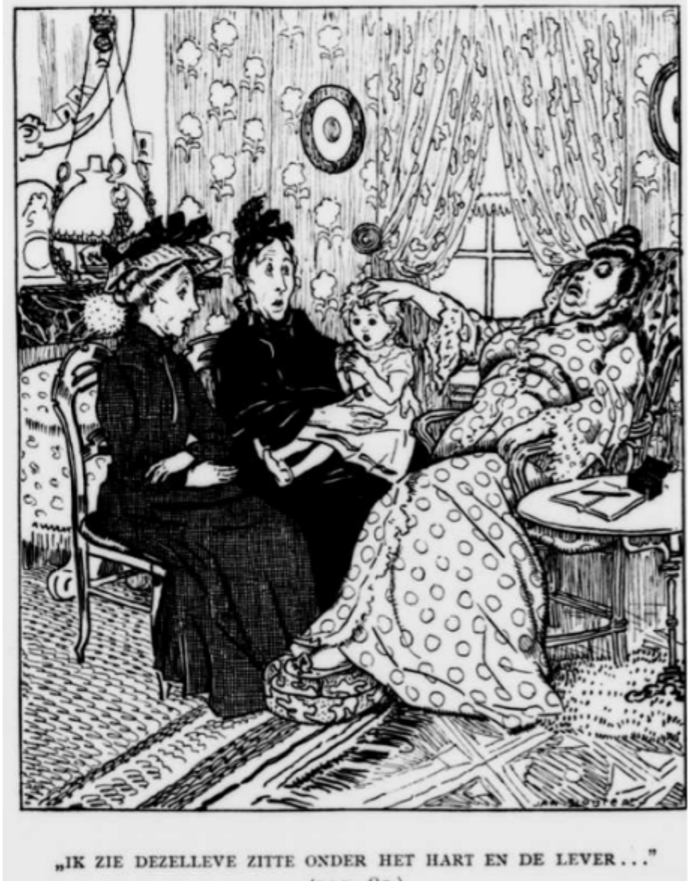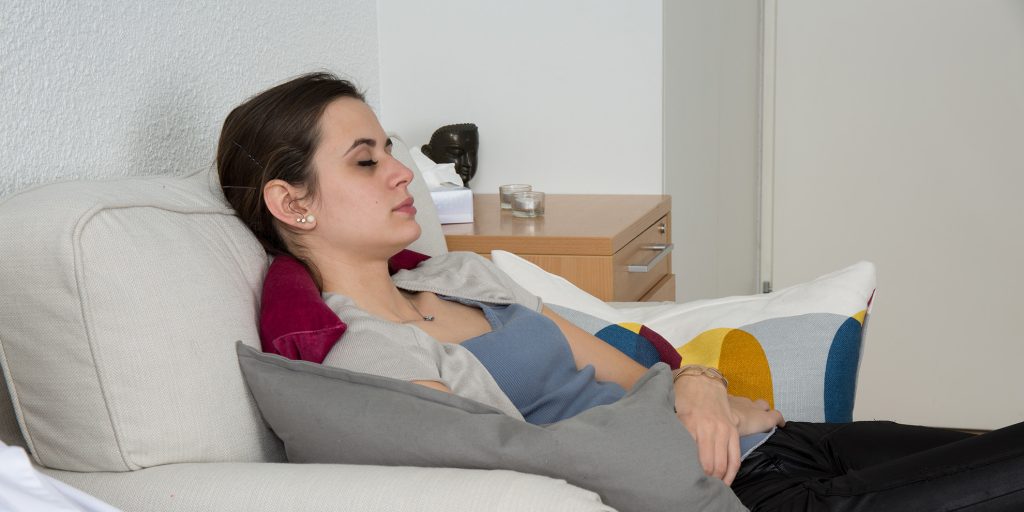“Veurstell’n in Zenuwslaap” Dutch dialect meaning giving suggestions to the subconscious.

Would it make any difference whether you talk about under hypnosis” or “in hypnosis”?
You would say you do because certainly in hypnotherapy it involves subtle suggestions and so what you say and how you say it is important.
Language as a healing medium is centuries old. Think of healing words ranging from the gentle whisper of a grandmother to the evocative words of a therapist. In the Dutch tradition, the art of “reading” has been a part of popular culture for hundreds of years. This practice seems to be a forerunner of structured modern techniques such as hypnotherapy, neuro-linguistic programming and current comfort talk.
‘Belezen’ refers to a form of folk medicine that was and is still practiced mainly in the northern, southern and eastern parts of the Netherlands. It consists of reciting spells or prayers, whispered or otherwise, to cure ailments, such as removing warts, reducing fevers or as protection against disease and other mischief.
In rural areas, the native language was prevalent and dialect was used in treatments, strengthening the personal connection with the patient.
In the Netherlands, reading developed as a mixture of pre-Christian and Christian rituals.Although modern medical science labels these practices as superstitions, readers were respected and sought out in many communities for their ability to help with ailments for which traditional medicine had no answer.
The power of regional variations
The sayings and prayers used by readers vary by region and are often rooted in the local dialect. A particular spell in Gronings may differ greatly from a similar spell in Twents. Many people are convinced that the local dialect enhances the power of an incantation or spell.
When you hear something in your own language, it often feels more familiar and convincing which makes the reading work better
The same goes for the spells and prayers that the patients themselves say. Many dozens are known against hiccups alone. In Over-Flakkee, when a hiccup attack occurs, they say:
‘Hiccup, hiccup, spray,
I give the hiccup to you,
I give the hiccup to Master Jan,
Who can handle it well.’
Often, local circumstances play a role. In coastal areas, hiccups are often given to the sea. On the Flemish seacoast , they say:
I and the hiccup
Go across the sea
I see myself again
But hiccup no more
(Three times)
And in North Holland, also by the sea:
Me and the hiccup
Went across the sea
I returned
And the hiccup stayed there.,
Rotterdam is best known for its many large transshipment ports:
Ikke pikke prou
I give the hiccups to you
I give the hiccups to another person
Who can endure the hiccups
Antwerp, also a port city, has several variations on this where the hiccup is passed on to someone else who can handle it better.
Often you have to recite the spell three times; sometimes just quickly and sometimes without hiccups.
The early years of hypnotherapy in the Netherlands
The late 19th and early 20th centuries were a turning point for hypnotherapy in the Netherlands. Two approaches emerged during this period: the scientific and experimental in urban areas and the traditional, often deeply rooted in folk medicine in rural areas. This involved language but also other regional cultural practices.
In cities, especially Amsterdam and The Hague, hypnotherapy was seen as a new and exciting field within medicine. Dr. A.W. van Renterghem and Frederik van Eeden with their hypnotherapy institute in Amsterdam, and Dr. Arie de Jong in The Hague were forerunners of that modern movement. While Van Renterghem, as a rural general practitioner, was accustomed to Zeeland dialects, in Amsterdam he had to deal with general civilized Dutch or even French and German.
Authoritarian language?
With the development of Dutch hypnotherapy also came the question of how best to formulate and express suggestions.
Because of their different view of man and society, this led to discussion between the young class-conscious van Eeden and the experienced patriarchal general practitioner Van Renterghem. The men had learned from Liébeault and Bernheim the authoritarian so-called command suggestion. Van Eeden believed that this mode of suggestion was useful for treating the uncivilized, children and docile individuals but that it does not work with more civilized people. They don’t want to be ordered around and don’t want to accept anything on authority, according to the Bussummer. Understandable, since van Eeden found his patients mainly in the educated writers’ world and among the inmates of his Walden colony.
He thought that among the civilized class, psychotherapy was unpopular because they do not understand and therefore do not trust it. They do not consider her a matter of authority and, as independent people, do not want to be commanded. Van Eeden wanted to abandon the system of authority and supremacy and learn to heal suggestively without increasing suggestibility. He had the most success with the ‘undeveloped’ and the very intelligent and explained this by: The former believe in the superior wisdom of the physician and this confidence makes authority superfluous, the latter are convinced by giving them a concept of suggestion, of ideoplasticism. According to van Renterghem this could be true, but most people do not belong to either of these two categories and the therapist is therefore mainly dependent on his knowledge of people and tactful action: “My experience teaches me that the trust of and consequently the authority over the patient can best be gained by showing him the necessary sympathy with his suffering, by listening to him calmly and if one is convinced by a careful examination that healing or improvement is possible, to make this clear to him according to his understanding, to speak to him in an encouraging way. “Moreover,” said van Renterghem, “most of our patients are old cases, nervous sufferers who have already tried everything and, as a last resort, seek refuge in the hypnotist. In many, the symptoms of illness are of an autosuggestive nature and their disbelief in medicine is great.Therefore, it is impracticable to cure them by psychic means without the help of the suggestion sleep or, in other words, increasing suggestibility.” Therefore, he strived for the deepest possible sleep although good results were also achieved with lighter sleep states.
Van Renterghem: “The vast majority of patients come with the preconceived idea that they only have a chance of healing if they enter deep hypnosis, and therefore it is useful to point out to them the large number of patients who healed by suggestive means without ever having had the sensation of hypnotic sleep.”
Stokvis (1937) emphasizes that suggestion works best when accompanied by attention to personal presentation: ‘This includes not only external care such as clothing and body care, but also extends to posture, behavior, facial expression, eye contact, tone of voice and sign language. Word choice and fluency also play a role. Specific phonetic nuances, such as monotone or lively speech, intonation, pronunciation and rhythm, as well as dialect and accent, all contribute to the efficacy of suggestion.’
In addition, there were other cultural differences between rural and urban areas such as reimbursement for hypnotic treatment. Van Renterghem recounts in his autobiography that in about 1878 he established a health fund in Heinkenszand and the surrounding area for “the little ushers, shopkeepers workers etc. In exchange for the fund tokens, he gave medical aid and medicine: ‘by this I was able to restrain a custom of paying the doctor with such foods as potatoes, peas, beans, hams and sausages, rather than in money‘. Payments with crafts, handicrafts or other services were also common in rural areas.
The ailments and treatments for which patients came also differed.
While urban hypnotists often dealt with neurotic symptoms, stress or psychosomatic complaints, the focus in rural areas was mainly on physical ailments such as pain, insomnia or digestive problems.
The language of therapy
The modern therapist must navigate cultural and regional differences during therapy. With the steady stream of migration and regional variations in the Netherlands, it is increasingly challenging for hypnotherapists to communicate clearly. Understanding and appreciating the cultural background of both the patient and the hypnotherapist is essential to the success of therapy. Cultural values, beliefs and norms influence the way individuals experience pain, illness and healing. They can also play a role in how willingly someone participates in certain therapies and what they think of them.
If the therapist does not understand his patient’s cultural beliefs and values, this can lead to misunderstandings, resistance and treatment failure.

This was evident when a young Afghan man, recently moved to Amsterdam, sought help from a hypnotherapist there for his anxiety symptoms. The man has experienced things in the war and also has to adjust to a new way of life in another country.
Afghan culture has beliefs around mental health and healing that may differ from Western understandings. During their first meeting, the therapist learns about the possible stigma surrounding mental health care in Afghanistan and the cultural interpretations of trance and dreams. With this knowledge, he adapts his techniques and language. Without this cultural sensitivity, the patient might feel misunderstood and uncomfortable, resulting in less effective treatment.
Language is the primary tool by which the hypnotherapist and patient communicate both consciously and unconsciously.
A patient who suffered trauma in a shipwreck is of little use in therapy if the therapist uses words or phrases, such as “safe haven” or “calm waters,” to evoke a sense of safety and calm during the session. In contrast, for a patient whose native language is Frisian, the use of a few Frisian words or phrases during the session may provide familiarity and comfort. Cultural and regional differences in language and expression can lead to misunderstandings or misinterpretations. What is considered a comforting expression in one culture or region may be felt completely differently in another context.This is of all times. Class differences also determine mutual language and thus the degree of understanding and acceptance by patients. Fine examples of this can be seen in older literary works. Where hypnosis still primarily served the well-to-do, the somnambulas or sleepers were mainly active in the lesser neighborhoods of major cities. S. Abramsz in his story “Medical Advice” (In Living Images, Sketches from the Capital, c. 1909) sketches such a séance in which a mother is worried about her infant daughter. The somnambule puts mother and child at ease:
“…children should be cheerful. Shall we go on a ride together now? By train? Well, off we go: Shh … shh … shh … shh … shh … Just like the locomotive, right? … … Shh … shh… shh. We’re here. Now back: Shh … shh …shh … shh … shh … shh …  sch …. So now we’re back with the lady. Did you enjoy it, girl? Fun, darling? Again? Shh … shh … shh … shh … wo-o-o-o-ah! Oh, dear, she’s such a little raisin bun, such a lovely little darling…”
sch …. So now we’re back with the lady. Did you enjoy it, girl? Fun, darling? Again? Shh … shh … shh … shh … wo-o-o-o-ah! Oh, dear, she’s such a little raisin bun, such a lovely little darling…”
But then, suddenly serious. “But then, suddenly serious, “Well, ma’am; would you please hold the child again? No, not you; the mother herself; it’s better for the magnetic flow, you see? And now we’ll proceed with the activities. You’ll see that I do it entirely without a magnetizer. I put myself to sleep. I’ve practiced it, you know. Works just as well. You must watch closely when I sleep to see if I write a prescription; you see, it’s as if it’s given to me… Alright, let’s begin…”
Even in satirical stories, the language difference occurs. Donkersloot emphasizes its existence:
“Mr. Dorus, former body magnetizer of the Pacha of Egypt, announces to his honored fellow-citizens and countrymen, that he has made an agreement with the, by all doctors and professors highly praised dormitory Madame Tobeia, whose incomparable clairvoyance has already restored health to so many a weak, even incurable sufferer. To speak daily; and if the patient can’t come, a worn hat is also good. Letters postage paid”
The somnambulist in question wonders how Dorus acquired the abilities of a magnetizer and how she herself suddenly became clairvoyant.:
“I’ve experienced a lot in the world and, as they say, am not easily startled, but still, when I read the newspaper, I saw stars before my eyes.
When had Dorus, who had lived continuously in Utrecht for twenty consecutive years, been to Egypt, a country that perhaps no longer exists? How can these doctors and professors speak of my clairvoyance when I have never been tested? Which ‘patients’ have I healed, when no one has ever called upon my help? And why call me ‘Madam’ when I wasn’t even a ‘miss’? I posed all these questions to my partner, who fobbed me off with the answer that I would hear even stranger things before I understood the art.
The hardest part for me was learning the magnetic language, i.e., understanding my master well when he asked me questions while I slept, and questions in which my answer was already implied.
It is impossible for me to tell you much about this, but I will give you some examples: Madamwas stomach,madam was intestines, To was eye, beia was mouth, Tobeia was head, ‘sharp view’ meant pain, a couple of stomps with the foot meant palpitation…”
Stories about magnetizers and somnambulism occur in most Dutch dialects. Achter den Waaldijk (1938) is set in Tiel and is about Farmer Geurt and his servant attending a performance by the stage hypnotist Bert Astron…:
Geurt was a sturdy, progressive farmer who kept up with the times and wanted to see for himself what this ‘devil’s charlatan’ was all about. “— But Piet, have you perhaps been under hypnosis too?
— Under hypnosis, Truly boss, there you have it. Now that I think about it, that guy also made me go through those arts after he looked at me so intensely, and afterwards, I always felt drowsy in my head. . I only felt better when I put my head under the pump.
— Under hypnosis, You, who the day before yesterday was so adamant that it didn’t exist and wanted to say that I was just pulling your leg… So now you do believe in it?’
it?’ — Do I believe in it? It’s a disgrace that such guys are allowed to roam free, that’s what I say. They should lock them up in prison or in Meerenberg because it’s outright witchcraft what that guy does to a person! And even if I could earn fifty guilders with it, they’ll never get me to go there again if that guy performs, I’ll tell you that.”
In “De Fryske Thyl Ulespegel or De wonderlike libbensskiednis fan Hantsje Pik” (1872), magnetizers are also mentioned:
“….. And if it turns out that the thing started, and the magnetizer came to Sloppegea, then I thought it a good thing that Jitse wasn’t involved. In my eyes, it was of great importance that everything went on without him. 240 Welmoed said she would keep everything to herself and think about how best to deceive Jitse if needed. Then we agreed that I would take a day off to look for the magnetizer in Leeuwarden. And once I had settled things with him, I would send her a note letting her know when she could expect us…”
The play by teacher P. Duynhoef “Sjappie Een spel uit de Bossche achterbuurten.” (approx. 1930-1950) was successful. In this, the class and language differences are clearly expressed: The main character, Sjappie, ends up in prison because of Zwarte P, who pretends he can hypnotize:
“…Kat (The third boy):” Yes, yes, yes, I had told my mother that the Black one always hypnotized me …”
More hypnosis in dialect can be found in “The Power of Mesmerism, Het Texelsch Volksleven, (1865); “Geesten” (1907, Rotterdam); “Te Laat! (1870, Katwijk) Keetelaar Oarend Spook (1894 Zutphen et al.); Oaver ‘t Magnetisme en ‘t Bijgeleuf En vertellingsken van Meister Maorten Baordman (1847, Harfsel/Gorsel Gelderland:)
Returning to the question “in hypnosis” or “under hypnosis.
Much of the confusion and misunderstanding surrounding hypnosis stems from miscommunication. Although the terms “under hypnosis” and “in hypnosis” seem superficially similar, in practice they carry different perceived values.
Hypnosis is often compared to sleep, and it makes it clear how big a difference it makes when an everyday phrase like “falling asleep” is mistaken for “falling asleep. For many people, the phrase “under hypnosis” suggests some form of outside domination or influence, while “in hypnosis” implies active participation and a personal experience.
Hypnotherapy is all about helping people feel stronger and more in control of their own lives. When we say “being in hypnosis,” it is as if you yourself are actively participating in a special way of thinking or feeling. That’s different from ‘being under hypnosis,’ which sounds like something just happens to you and you can’t really do anything about it.”
Such linguistic nuances can significantly affect a client’s experience. Being “under hypnosis” can cause fears of loss of control, false expectations or a passive attitude during sessions. Language and clear communication are not only crucial in preventing misunderstandings, but also promote the success and quality of the therapeutic relationship.
In certain dialects, the terms “under hypnosis” and “in hypnosis” may have such strong regional coloring that they contribute to misunderstandings or stigmatization of hypnotherapy practice. In some cultures, “being under hypnosis” may be seen as a weakness or susceptibility to external influences, while “being in hypnosis” may be perceived as more neutral or even positive.
Some words can even lead to complete misunderstanding. Westerkwartiers, a dialect spoken in southwestern Groningen has no hypnosis but speaks of nerve sleep. A suggestion is called a “veurstel” in Western dialect, and to suggest is thus “veurstell’n.
Folklore researcher J. Rasch recorded a folk saying about self-suggestion in 1935 that says, “Imagination is worse than third-day fever. With that opinion, a hypnotherapist will achieve little if he encourages his patient to use his imagination!
Dutch is far from homogeneous. The great variation is already apparent when we listen to the neatest forms of “it” Dutch in the Netherlands and in Flanders. The Meertens Institute countshundreds of dialects with many words of their own. It noted the following variants for the word psychologist: psycholooch (Frisian); spychologist (Leids): spiegeloog (Evergems); spiechologist (Kaatsheuvels); zedenpreker (moralist) (Amsterdams); Zieleknieper (Hoogeveen); mirror eye (Utrechts)
When it comes to dialects, it would be best for a hypnotherapist to first ask what words or expressions a person likes. That way, the therapy feels more familiar to the patient and gets him excited. Some examples include:
- Fries: “With which words or expressions do you feel better? Do you feel better with ‘under a spell’ or ‘under suggestion’?”
- Westerkwartiers: “With which words or expressions do you feel better? Do you feel better with ‘in a hypnotic state’ or ‘under hypnosis’?”
- Brabantian: “Which words or expressions do you feel comfortable with? Do you feel better with ‘being enchanted’ or ‘possession’?”
- Twents: “Which words or phrases do you feel better with? Do you feel better when ‘in hypnosis’ or ‘under hypnosis’?” (No specific Twente term known)
- Gronings: “With which words or expressions do you feel best? Do you feel better with ‘in hypnosis’ or ‘under hypnosis'” (No specific Groningen term known)
- Limburgs: “Which do you prefer: ‘in hypnosis’ or ‘under hypnosis’?
- Street Language: “What words or phrases do you chill with the most? Do you chill more with ‘in trance’ or ‘under trance,’ you know?”
Literature
Abramsz, S. Medical advice in: ‘Levende beelden Schetsen uit de hoofdstad’
z.j. (ca. 1909), P. van Belkum, Zutphen,
Baordman, Maorten Oaver ‘t Magnetisme en ‘t Bijgeleuf En Vertellingsken van Meister Maorten Baordman
1847, Geldersche Volksalmanak, 1 ed.
Brusse, M.J. Spirits
1907, W.L. & J. Brusse, Rotterdam, 1 ed.
Buysse, P. Too late! from Leunemaet, De dorpsschipper en zijne twee huwelijken 1870, Gebr. V.d. Hoek, Leiden
Donkersloot, N.B. Uit het dagboek van een slaapster z.g. somnambule
1871, J.C. Loman Jr., Amsterdam
Doorne, J.H. van & J. Feith, Achter den Waaldijk Humor van het platteland
1938, A. van Loon, 1 ed.
Duynhoef, P. Sjappie Een spel uit de Bossche achter-buurten in vier bedrijven
g.d., Tooneelfonds, Kinheim, 1 ed.
Dykstra, Waling, De Fryske Thyl Ulespegel, or De wonderlike libbensskiednis fan Hantsje Pik
1862, T.Telenga, 1 ed.
Keetelaar, Oarend Spook Novelle
1894, Zutphensche courant
Rasch, J. Nederlandsche Folklore Gebruiken Gewoonten Volksgeloof Uitdrukkingen
1935, Kluwer
Renterghem, A.W. van Autobiographie 2 volumes
1993, BTTE Zeeland Gazet, 2 ed., ca.1600 pp., Original (10 ex.) 1924-1927.
Stokvis, B. Hypnose in de geneeskundige practijk
1937, De Tijdstroom, Lochem
©2023, Johan Eland
Note of translator: Some of the translations, especially the rhymes, are made to convey the meaning rather than maintain their poetic nature. In many cases, cultural rhymes and sayings can’t be translated perfectly, but the goal here was to keep the meaning intact. The translation aims to keep the tone and feeling of the original text, but due to the nature of the Dutch language and its idioms, some phrasings might feel a bit different in English. These are direct translations, and some contextual nuances might be lost in the process. For the Dutch or dialect check this link.


